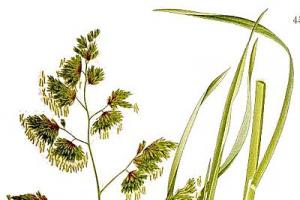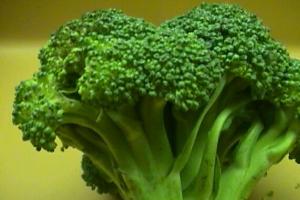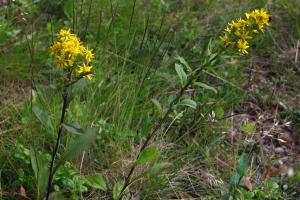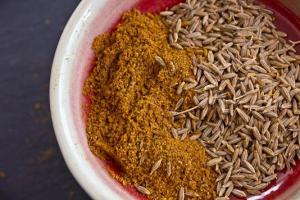Many housewives believe that cumin and cumin are the same thing. Is this really true? In this article we will study this issue in detail: we will tell you what spices such as cumin and cumin are, how they differ (photos of each spice will be presented below) and where they are used.
Queen of Oriental Spices
Zira is a plant belonging to the small genus Kmin of the Apiaceae family. Quite often this spice is called Roman caraway, or cumin. According to many, cumin and cumin are the same thing, but this is far from true. They really look very similar, but the taste of these spices is completely different. Central Asia is considered the birthplace of zira. It has long been used as a spice in Ancient India, Greece, Rome, and the Greeks and Romans used cumin for treatment - this is mentioned in the works of Hippocrates, Pliny the Elder and Dioscorides.
There are several types of cumin with different tastes and aroma. The most common are Persian and Kirman cumin. Zira has a pungent taste and a bright aroma with nutty notes.

Description of caraway
One of the oldest plants discovered in Stone Age pile buildings is caraway. In our state, this plant is found in meadows, along roadways, along forest edges, almost anywhere. It belongs to the celery family. In the first year of life, a fleshy, weakly branched root crop and a rosette of feathery leaves are formed; in the second year, a branched stem is ejected, the height of which can reach 90 centimeters. Cumin blooms in July. The fruits are elongated two-seeds. The seeds are small, ribbed. Young leaves contain about 45% ascorbic acid, and root vegetables accumulate sugar.
Black cumin grows in the Caucasus, the Mediterranean and Asia Minor. This spice is often perceived as cumin. We will try to find out how the oriental spice differs from black cumin. Both spices have a pungent odor and bitter taste, but the taste characteristics are noticeably different, which is why they are used differently in cooking. Not a single oriental pilaf is complete without the addition of cumin; in addition, it is often present in meat dishes, sausages and cheeses. It is mainly used as a spice in the preparation of confectionery, drinks and to add flavor to pickles.

Zira and cumin: how do they differ in chemical composition?
Cumin seeds contain about 20% fatty oil, from 2.5 to 4% essential oils (which contain cuminaldehyde, kimole, paracymol, kimin and carvone), 10-15% proteins, no more than 16% gum, and flavonoids, cumic and beta-pinins, tannins, B vitamins, dipentene, beta-phellandrene, ascorbic acid, perylaldehyde, calcium, magnesium, phosphorus and other minerals.
The composition of cumin seeds includes flavonoids, fatty and essential oils, protein compounds, coumarins, minerals and tannins. The essential oil contains limonene, carvone and carvacrol (it is thanks to this substance that the special aroma appears). A large amount of ascorbic acid accumulates in the roots of cumin.
Useful properties of spices
As you can see in the photo, cumin and cumin are very similar in appearance. How are these spices different? Properties. Regular consumption of cumin helps in the fight against insomnia, amnesia, nervous exhaustion, migraines, stomach colic, dyspepsia, flatulence, diarrhea, bronchitis, cholelithiasis and kidney stones, cough. The benefits of cumin do not end there. This oriental spice normalizes digestion, prevents blood clots, protects the body from heart attacks, improves the functioning of the cardiovascular system, and helps improve vision and brain activity.
Zira has a tonic, diuretic and antiseptic effect, increases libido, and removes toxins from the body. Cumin is a lifesaver in the first months of pregnancy: it relieves nausea and prevents bloating. Pediatricians use cumin to treat children's flatulence, and the Greeks prepare medicinal children's tea from it.
Cumin fruits are also widely used in medicine (used to treat headaches, pneumonia and bronchitis). The spice is considered a good antiseptic. It has cumin and antihelminthic properties. Essential oil helps improve digestion, suppress fermentation processes, normalize bile secretion, relax smooth muscles, and in addition has a sedative effect. The spice seeds are recommended for use for flatulence, urinary tract pathology, constipation and intestinal atony.

By becoming familiar with the beneficial properties of such popular spices as cumin and cumin (we have already found out what the difference is between outwardly similar plants), you can not only add an extraordinary aroma to your dishes, but also improve your health.
Contraindications for use
Is everyone allowed to eat such healthy seasonings as cumin and cumin? We have already figured out how they differ. Let's talk about in what cases it is recommended to stop using these spices. Thus, the use of cumin is contraindicated for duodenal and stomach ulcers.
People with a weak heart should avoid eating meat and fish dishes seasoned with cumin, as the likelihood of a heart attack increases. The spice is not recommended for digestive juice produced by the stomach and for anemia. Cumin is contraindicated for thrombophlebitis and thrombosis. Seeds consumed in large quantities can lead to rejection of transplanted organs.

Application
Caraway fruits are used to obtain essential oil; young shoots are added to salads, soups and pates. Today it is one of the most popular spices, which is used to flavor confectionery products, alcoholic beverages, marinades, sauces and canned food. Essential oil has been used in cosmetology and medicine.
Zira seeds can be used in cooking either whole or ground. In India, cumin is added to vegetable dishes, in Greece, Simir-style sausages are prepared with this seasoning, in Uzbekistan - pilaf, various soups, cold appetizers, in Kyrgyzstan - marinades and sauces, in Armenia - dry-cured sausage sujuk.

Beginner cooks, after reading this material, will be able to safely answer the questions: “What are cumin and cumin used for? How are these spices different and what beneficial properties do they have?
), which contain a spice common in the East called cumin. As I already said, I am a beginner in cooking Vedic dishes, so I try to thoroughly follow all the tips and recommendations, and also carefully read the theoretical part before starting to prepare dishes.However, in the case of cumin, the theory turned out to be incomplete. Some time after publishing recipes on LiveJournal, where I put an equal sign between cumin, cumin and Indian cumin, I was corrected that these are three different spices. And I had to look for information in cookbooks again, although before that I had specifically dealt with this spice, since I didn’t have it in the house before, and I just didn’t know what it was and what it looked like. This is what I came up with as a result of further book and Internet research.
I'll start with a quote from Stalik Khankishiev's book "Cauldron, barbecue and other men's pleasures." The book, of course, is far (or rather, directly opposite) from the principles of Vedic cooking, but it was in it that I discovered the first detailed information on synonyms for cumin. I think this information can be trusted, since it comes from an oriental person who is familiar first-hand with various spices, including this one.“Zira is a spice that grows in Central Asia, India and Iran. It is very similar in appearance to cumin, which often leads to confusion in many cookbooks, especially translated ones, where cumin is called either cumin in English, or Indian cumin in German. Sometimes unfortunate translators, when translating Indian recipes, completely omit the adjective “Indian” - it seems to them to be useless, since we are talking about Indian cuisine - and leave only “cumin” in the recipe.
Compilers who compile books about “a thousand and one recipes”, of course, do not take this point into account, and as a result, many Asian recipes are circulating around the world, where cumin is added to meat dishes. But for Indian meat (and not only) dishes, cumin is mainly used in various spice mixtures, while cumin is mostly used in baking and in European vegetable dishes. Need I say how different they are in taste and aroma?
Therefore, if you are reading an Indian or simply Asian recipe involving meat or chicken, then keep in mind that you should not use cumin, but cumin.
So, the name. The common name for this spice in India is "jeera", in England - cumin, in Germany - Indian cumin, and in Central Asia - cumin. Let's call it that in the future - zira.
There are black and yellow cumin. The latter comes to us from Iran and India, often in ground form, and is sold in any decent supermarket. Uzbek pilafs use small black cumin, which grows wild in the mountains of Tajikistan and Kyrgyzstan. You can, of course, use large and pure Indian cumin in Uzbek pilaf, but you should keep in mind that these two types of cumin differ in taste and aroma in the same way as, say, apples of the Jonathan and Antonovka varieties can differ."
Recently a new channel “Kitchen TV” appeared on my cable television. On this channel, among other interesting stories, there are two programs dedicated to Indian cuisine. One of them is run by an Indian woman, from which I assume that she is well acquainted with the cuisine of her people. The second program is hosted by a European who visits various Indian chefs to learn from them the skills of preparing Indian dishes, respectively, and here the recipes belong to the original Indians.
So... When translating these programs into Russian, exactly what Stalik Khankishiev wrote about happens: in all recipes (whether they are meat, fish, vegetable, vegetarian, Vedic, etc.) cumin is used! There is no talk of any cumin, cumin or Indian cumin. From which I conclude that the naming error is quite common.
You can see the difference between regular cumin and cumin: both are sold everywhere. Bite one grain and then another, fry a teaspoon of some seeds and others in a nearby frying pan. Indeed, both taste and aroma are different.
Therefore, the first conclusion I made: there is Indian cumin, and there is non-Indian cumin. The conclusion may be funny, but for those who have not asked the question of comparison, it is very important and necessary. Because it’s very easy to spoil a dish with the wrong spice, especially since not everyone likes regular cumin due to its very peculiar taste (my son, for example, doesn’t even eat bread with cumin if he has to buy it for lack of anything else).
Convinced that cumin, cumin and Indian cumin were the same spice, I decided to check it out on the Internet. Because S. Khankishiev’s book is good, but they still corrected me that these are different spices. The vast majority of sites confirmed the version that all three names are synonyms. But some sources still disputed this version.
For example,
Information is given on the differences between these three spices. But I already understood that ordinary cumin should not be confused with Indian cumin even before (without) this article. It remains to deal with cumin and cumin. But, unfortunately, get reliable information outside the East is almost impossible.Therefore, I decided to take an experimental route and check what the shops and markets in my city offer, and then compare the appearance of all the spices I found.
I bought this box in the largest and most expensive supermarket, which has almost everything: 
I bought this bag at a regular inexpensive market in a stall with all sorts of spices: 
I bought this bag in a specialized store with Indian goods: 
This is what these three acquisitions look like in comparison: 
I’m sorry that my camera is not strong enough to capture the details with the necessary quality, but in words I can add that the differences between these three varieties of cumin are only in the fact that in one bag
(from the market, the company "Pripravych", in the previous photo - the left spoon) the seeds were interspersed with green. In all other respects, I did not find any differences. The smell was also the same in all three cases.
For the purity of the experiment, I was not too lazy to go to my friend, who has in her stock some cumin from Syria, brought by a Syrian friend. At the same time I’m posting this photo: 
By the way, I noticed the names. In the first and second photos you can see that my purchase was called cumin, and in parentheses - cumin. In the third photo, the inscription exactly corresponds to the quote from S. Khankishiev’s book - jerra (whole - means whole, unground), and the second name is cumin. That is, all three sellers believe that cumin and cumin are the same thing.
It is a pity that there was no information on the packaging about where these seeds grew and were collected. It is only known that TRS is Great Britain, and “Pripravych” is Russia)))
Well, to finally dot the i’s, I bought a bag of cumin. Firstly, it is called that, so it is difficult to confuse it with cumin (if you understand the difference between Indian and ordinary cumin). Secondly, Caraway was written on the bag (and cumin is spelled Cuminum in Latin), which can also serve as a guide when purchasing to avoid mistakes when purchasing spices.
This is what ordinary cumin looks like: 
When compared to cumin, cumin has a more curved shape and a richer (browner) color. And the smell, of course, differs significantly: 
This confusion with spices could also occur because they all belong to the umbelliferae family, that is, they have approximately the same appearance, but the smell cannot be confused.
In conclusion, I will give two quotes from books on Vedic cooking.
Yamuna Devi in her book “Favorite Dishes of Indian Vegetarian Cuisine” writes:
"The seeds of Indian cumin, known as jeera or safed jeera. It is a related annual plant of the umbelliferous family Cumimum Cuminum, related to common cumin. Jeera has yellowish or grayish-brown seeds that are elongated, slightly pointed and ribbed. Used for thousands of years in Vedic cooking as a spice , this cumin is still widely used in the national cuisine of Northern, Eastern, Western and Central India. As a rule, Indian cumin seeds - whole, ground or crushed - are always fried, which brings out their strong and unusually pleasant aroma. They are fried without oil in frying pan until they darken several shades, and then grind coarsely. In this form, they make a good spicy addition to stewed vegetables, raitas, kachambers, dal and rice. When ground, cumin seeds do not last very long, so try to buy good cumin quality and in small quantities".
Adiraja Das in his book Vedic Cookery writes:
"Indian cumin seeds (cumin, ajgon or ayowan) (safed jeera, sabut and pesa). White Indian cumin seeds - Cumimum Cuminum - are an important ingredient in vegetable curry recipes, rice dishes, snacks and dahl. Although ground cumin is sold in supermarkets, it is better grind it yourself. If the recipe calls for toasted cumin, place the required amount of seeds in a preheated frying pan and toast them, shaking the pan occasionally, until they darken a little and begin to release a specific aroma. If you call for toasted ground cumin, grind the already toasted seeds into in an electric coffee grinder or in a mortar. Cumin seeds must be properly roasted to impart their characteristic flavor to food. When preparing masala, they are one of the first to be added to the oil. Cumin seeds aid digestion and share the healing properties of Kalinji seeds.
Black cumin seeds (kala jeera) - Cuminum Nigrum - are darker and smaller than white ones, have a more bitter taste and pungent odor. They do not require as long roasting as white cumin seeds.
We do not sell white cumin seeds, used in Indian cooking (the book was published in 1993, since then the situation could probably have changed. - Comment from the author of the post). Devotees bring them from India or buy them at the Bombay restaurant in Moscow. Many devotees, in the absence of Indian cumin, use regular cumin, although it has a completely different taste and cannot be considered an adequate substitute. Black cumin seeds are sold in the markets of Central Asia, where they are known as cumin."
These quotes complicated things somewhat in that I had two additional questions:
1) did I buy black or white cumin?
2) is azhgon (ayowan) another synonym for cumin?
But I think these questions can be left unanswered for the simple reason that the stores in my city sell only one spice, photographs of which I showed you. It’s hard to say what it’s actually called. And it’s probably not necessary: regardless of the name, I’m unlikely to be able to buy anything else, so I’ll trust the manufacturers who equally call this spice cumin or cumin.
CUMIN, ZIRA AND CUMIN: WHAT ARE THEY DIFFERENT AND WHAT ARE THEY SIMILAR? Cumin, cumin, cumin…. There is chaos in European cookbooks because many authors confuse all these plants. This is due not only to similar names and synonymous concepts, but also to the almost identical appearance of the seeds of these plants, which are used to season food. But if you taste a cumin seed and a cumin seed, you will understand that these are not only biologically different species, but also a completely special taste. Without going into botanical subtleties, we can say that cumin and cumin are one and the same. At least in cooking. This is one of those spices that gives oriental dishes that typical spicy taste. Indian peasants grow it in their gardens, just like we grow parsley. It is widespread in Central Asia, and our neighbors from the former Soviet republics use it in many of their dishes. In particular, cumin is often added to the famous pilaf. Confusion between spices arose not only because of the similar name. Both plants use seeds as food. They are very similar in appearance. Cumin is a little darker. But if you consider that both plants have several varieties, and each seed may have a different shade, it is very easy to get confused. The only way out is to try it by heart. Spices have completely different tastes. That's why they are used in different dishes. Zira has a fresh, light nutty aroma. When a spice is crushed into powder, it disappears very quickly, so you only need to grind it before preparing a dish. It is generally not recommended to buy already ground cumin. You can clearly feel the difference between whole seeds added to a dish and ground powder. Cumin is much more fiery and pungent, with citrus notes. But its aroma is also fresh and spicy. However, the twin brothers caraway and cumin have one common secret. In order for the seasoning to reveal its aroma, the seeds need to be fried. You can heat them in a dry frying pan or throw them into hot oil. The main thing in this matter is not to overdo it. If you keep caraway seeds or cumin seeds on the fire for too long, they begin to taste bitter and give the dish a burnt taste. When the dish does not require heat treatment, you can thoroughly grind the seeds. The effect will be the same as when frying. HOW TO USE CUMIN? Perhaps, cumin is most often used for meat dishes. Tajik and Uzbek pilaf is unthinkable without it, and here it is the whole fruits that are used. In Kyrgyzstan, meat is marinated with cumin before heat treatment. Cumin is the main spice for Bulgarian sausage sudzhuk. Not a single famous Indian sauce is complete without cumin, be it a curry sauce or a multi-component garam masala seasoning. By the way, Mexican chili sauce also involves the use of cumin. Cumin is an excellent seasoning for typical vegetarian grain dishes. If you fry it in ghee and then add boiled rice, you will get an excellent side dish that can replace a full meal. Jeera powder can be thrown into the pan before frying vegetables or mushrooms. The famous hummus, a spicy Arabian vegetarian spread made from chickpeas, is unthinkable. In general, if you cook legumes, try adding this spice. In addition to the fact that it gives them an exotic taste, it also reduces gas formation in the intestines. HOW TO USE CAUMIN? Cumin is traditionally used for bread baking. The second most popular area of cooking in which this spice is indispensable is vegetable preparations. If you throw a few caraway seeds into pickled cucumbers or tomatoes instead of the usual dill umbrellas, the appetizer will acquire a unique flavor. Almost all cabbage dishes are good with this spice. This vegetable can be salted, fermented, stewed and fried by adding caraway seeds. They are also used for making drinks. The easiest thing you can do is brew the seeds like tea, adding zest to taste. Cumin is also used in brewing. They insist on kvass. In Scandinavia they love caraway vodka and liqueurs. Cumin is also sometimes used in pilaf. For example, Turkmen pilaf, unlike Uzbek and Tajik, involves the use of caraway seeds, not cumin. Still, this is less typical. A FEW UNUSUAL FACTS ABOUT CUMIN AND CUMIN: Cumin is a strong poison for birds. Even a couple of grains that a sparrow pecks can become a deadly poison for it. Often this grass is sown with clover intended for livestock. It improves digestion for cows, increases milk yield and repels birds; Five years ago in Russia, cumin was recognized as a plant containing potent, narcotic or toxic substances. Therefore, it cannot be used in the manufacture of pharmaceutical drugs. The spice that can be bought in our markets is another subspecies of cumin, which does not contain a poisonous component. The same list of hazardous substances includes parsley and nutmeg; If you add cumin to a dish, you can forget about other seasonings. It doesn't go well with almost anything. The strong aroma and pungent taste overwhelms all other spices; In Greece, young children are treated with tea made from brewed cumin seeds. It is considered a good remedy for infant colic, and is a kind of analogue of our dill water; Cumin is considered an excellent drug for improving lactation. Many mothers of infants add it to dishes and teas. But it is better for pregnant women to avoid eating food flavored with this spice. Its tonic effect can cause premature birth; In general, cumin has a beneficial effect on the digestive tract. But with excessive consumption of dishes seasoned with this spice, you can get problems with stool. After all, it has a fixing effect; If you haven't roasted the cumin in advance, you can add it 10-15 minutes before the dish is ready. Longer heat treatment will kill the flavor of the spice and spoil the food. The essential oil that gives the seasoning its unique smell will simply evaporate.
08.04.2018
Find out what sets cumin apart from other famous herbs, read about its amazing medicinal properties and contraindications for use..
What is cumin?
Cumin is a spice in the form of dark brown crescent-shaped seeds, with several ridges running along the surface, with an islandy-sweet and slightly peppery aroma.
Cumin seeds are common in European and Mediterranean cooking, and their complex flavor lends itself to both savory and sweet dishes. It is an important component of most traditional rye bread recipes.
You'll need cumin seeds if you plan to make delicious sauerkraut, Polish sausage, or Tunisian harissa.
It can also be found in desserts, alcoholic beverages, and as an ingredient in cosmetic products.
What cumin and its seeds look like - photo

Cumin seeds are grayish-green or light brown fruits up to 6 mm in size with pronounced ribbing.
general description
The genus Caraway (Carum) includes more than 30 plant species distributed throughout the Northern Hemisphere. Only one is grown as a spice – Cumin (Carum Carvi).
It belongs to the Umbelliferae or Apiaceae family, which also includes other well-known spices such as fennel, cumin, anise and dill.
It is a low (50-60 cm) biennial plant with finely dissected leaves and a branched stem ending in umbels of inflorescences with tiny pinkish-white flowers or fragrant fruits.


The greens and roots of cumin are also edible and quite aromatic, but dried seeds, which form in the second year of the plant’s life, are popular as a seasoning.
How to obtain cumin seasoning
Cumin seeds are collected when they are still slightly unripe, since when ripe they easily crack and quickly fall to the ground. The plants are cut and left to ripen under canopies. Then they are threshed and sifted to remove debris. The finished fruits are packed in paper bags and sent for sale.
Cumin and cumin - what is the difference between them
Cumin is sometimes confused with cumin; many mistakenly believe that they are the same thing; the differences between these two spices are clearly presented in the photo:

Zira is more pungent in taste, lighter in color, and the seeds are larger than those of cumin. The aroma of cumin is also different from cumin: it is stronger and spicy due to the content of essential oils.
Jeera is the dried seed of the Cumin cyminum plant, which resembles parsley in appearance. The seeds are used both whole and crushed in cooking in many countries. You can learn more about cumin from.
Cumin seeds from the Carum carvi plant are crescent-shaped, long, and have five pale ribs.
Cumin is more common in German cuisine, where it is usually used whole rather than ground. It has an anise-like aroma and flavor that is popular in breads, especially rye, as well as cheeses, sauerkraut, and root vegetables.
What is the taste and smell of cumin seeds?
Caraway seeds have a very strong, distinctive aroma, reminiscent of anise, but with soft earthy and nutty notes and a warm, slightly pungent flavor.
It's such a powerful spice that most recipes only need a small amount.
How to choose and where to buy cumin seeds
Cumin seeds are sold either in seed form or in ground form. In the store, buy whole seeds instead of ground ones, as unscrupulous manufacturers often falsify the powder by mixing in extraneous additives.
The darker the color of cumin fruits, the more essential oil they contain and the better the quality of the seasoning.
How and how long to store cumin seeds
Store whole cumin seeds in a cool, dry place, away from light, in airtight containers for 2-3 years. If necessary, they are crushed using a coffee grinder or manually in a mortar.
Ground spices very quickly lose their taste. Ground cumin is stored in the refrigerator in tightly closed glass jars and used as early as possible, since its shelf life is much shorter: only 2-3 months.
Chemical composition
Cumin seeds have high nutritional value as they contain many health-promoting nutrients, minerals, vitamins and antioxidants.
Nutritional value of cumin seeds (Carum carvi) per 100 g.
| Name | Quantity | Percentage of daily value, % |
|---|---|---|
| Energy value (calorie content) | 333 Kcal | 17 |
| Carbohydrates | 49.90 g | 38 |
| Protein | 19.77 g | 35 |
| Fats | 14.59 g | 48 |
| Dietary fiber (fiber) | 38 g | 100 |
| Folates | 10 mcg | 2,5 |
| Niacin | 3.606 mg | 23 |
| Pyridoxine | 0.360 mg | 28 |
| Riboflavin | 0.379 mg | 29 |
| Thiamine | 0.383 mg | 32 |
| Vitamin A | 363 IU | 12 |
| Vitamin C | 21 mg | 35 |
| Vitamin E | 2.5 mg | 17 |
| Sodium | 17 mg | 1 |
| Potassium | 1351 mg | 29 |
| Calcium | 689 mg | 69 |
| Copper | 0.910 mg | 101 |
| Iron | 16.23 mg | 203 |
| Magnesium | 258 mg | 64.5 |
| Manganese | 1,300 mg | 56,5 |
| Phosphorus | 568 mg | 81 |
| Zinc | 5.5 mg | 50 |
| Beta carotene | 189 mcg | - |
| Cryptoxanthin | 58 mcg | - |
| Lutein-zeaxanthin | 205 mcg | - |
Physiological role
Cumin seeds have the following effects on the body:
- anthelmintic;
- digestive;
- immunostimulating;
- diuretic;
- antibacterial;
- expectorant;
- antitussive.
Medicinal properties of cumin seeds
Cumin is used primarily as a spice and food flavoring, but is also sold in dietary supplement form for its numerous health benefits.
Cumin seeds are rich in fiber: 100 g of seeds contain 38 g of fiber, which is 100% of the daily recommended intake. Soluble as well as insoluble dietary fiber increases the bulk of food and helps prevent constipation by speeding up its passage through the intestines.
Fiber also absorbs toxins that may be in food, and thus helps protect the colon lining from cancer. Additionally, dietary fiber binds to bile salts (derived from cholesterol) and reduces their reabsorption in the colon and thus helps lower blood cholesterol levels.
Cumin contains healthy essential oils: carvone, limonene, carveol, pinene, cumic aldehyde, furfural and thujone, which have antioxidant, digestive, and antimicrobial properties.
The seeds contain flavonoid antioxidants such as lutein, carotene, cryptoxanthin and zeaxanthin. These compounds remove harmful free radicals from the body and thereby protect against cancer, infection, aging and degenerative neurological diseases.
Cumin is an excellent source of minerals such as:
- Copper is an important element for the process of hematopoiesis in the body and is involved in the synthesis of red blood cells and white blood cells.
- Iron is necessary for the formation of red blood cells.
- Zinc regulates many vital functions in the body, including growth, development, digestion and sperm production.
- Potassium is an electrolyte that helps the heart work efficiently and maintain both healthy blood pressure and stable heart function.
- Manganese is used by the body as a co-factor for the powerful antioxidant enzyme superoxide dismutase.
- Calcium is important for normal permeability of cell membranes and blood vessels.
- Selenium stimulates the formation of antibodies, white blood cells, and is involved in the production of red blood cells.
- Magnesium is the main participant in energy processes, neuromuscular transmission and the mechanism of muscle contraction.
Caraway seeds contain many vital vitamins: A, E, C, as well as group B - thiamine, pyridoxine, riboflavin and niacin.
Cumin, like anything consumed in excess, can cause harm to the body. Too much of this spice sometimes leads to heartburn and causes belching.
Pregnant women should be careful with this spice, especially in the first months.
Breastfeeding women should consult their gynecologists before consuming cumin seeds to stimulate lactation.
For diabetics, it is recommended to check your blood sugar levels before consuming cumin as this spice tends to lower your blood sugar levels.
Use of cumin seeds in cooking
Whole cumin fruits are added in the middle of the cooking process or 10-15 minutes before cooking, placing them in a cloth bag and then removing them.
If a recipe calls for ground seeds, it is best to grind them immediately before use.
Cumin is most often used in baked goods such as rye bread, buns and cookies, and here are a few other dishes where it is added:
- It is an important flavoring agent for some cheeses, such as Danish Havarti and Swiss Tilsiter.
- It is used for the production of alcoholic drinks aquavit and schnapps.
- In Indian cooking, cumin seeds are used in curries and dals.
- In North African countries such as Morocco and Algeria, they are added to roast lamb.
- Ground cumin goes well with fried potatoes, broccoli, carrots, and beets.
- It is added to dishes made from legumes or cabbage in any of its forms.
- Good as a marinade for fish and lamb mixed with garlic and lemon juice.
- Cumin goes well with all spices, but works best with herbs and spices from its own family - dill, coriander, cumin.
- Great for recipes containing cabbage, feta cheese or cheese.
- Caraway seeds are added to some sauerkraut recipes.
- Cumin is often added to Hungarian goulash along with paprika.
- Along with other spicy seasonings, cumin seeds are often added to sausages and meat dishes.
- This seasoning is used for vegetable salads and grilled vegetables.
1 teaspoon contains approximately 3.5 g of cumin seeds. One pinch contains about 0.5 g.
How much ground cumin to add to dishes:
- For 1 kg of meat (for goulash, roast) - 1.5 tsp. (5-7 g)
- For 1 kg of minced meat – 1 tsp (5 g)
- For 1 kg of flour (for baking bread, etc.) – 2 tsp. (10 g)
- For 1 kg of sauerkraut – 1 tsp.
Cumin grown in warm climates has a more intense aroma, as it contains 2 times more essential oils than that grown in cool climates, so you will need half as much of it.
Recipe for delicious sauerkraut with caraway seeds - video
How to replace cumin seeds in a recipe
If cumin seeds aren't easy to find where you live or are out of stock, consider any of these effective substitutes. Most alternatives can be found in your local grocery store or in the spice racks in your home.
- Anise seeds. This spice is from the same family, with a very similar smell. Note that anise seeds work best as a cumin substitute in baked goods (breads and cookies). Their strong flavor can withstand baking without becoming bitter. When using anise seeds instead of cumin, use less than the recipe calls for.
- Fennel seeds. These two spices are so similar in taste and appearance that they are often mistaken for each other. Fennel seeds are best used as a substitute for cumin seeds in curries, stews and the like that require long cooking times. In these dishes, you also need a spice that can compete with other strong flavors. If you are using fennel seeds instead of cumin, use the same amount.
- Dill seeds are another way to get a cumin-like flavor. Dill belongs to the same family, which explains the similarity in taste and smell. Its seeds are ideal for use in pureed soups and for cooking cabbage.
- Star anise (star anise) is another spice that can be used to replace cumin. Its powerful scent can be overwhelming, so add a little at a time.
Scientific research has confirmed that cumin is beneficial to health, as it has medicinal properties, but possible harm must also be taken into account (contraindications). Although it is too early to recommend cumin supplements as standard treatment, including this spice in your diet will be beneficial as it contains a large amount of nutrients.
Same? What is the difference between them? Indeed, the plants are very similar in appearance, as are the spices that are made from them. All plants are included in the Apiaceae family. However, there are differences between them, both in the taste of the spices and in the smell.
Confusion has led to the fact that for many spice manufacturers, cumin and cumin are one and the same thing. As a basis for this article, we took the book “The Great Cookbook of Spices” by the EKSMO publishing house (translation from German by M. Tekegalieva). We consider it the most authoritative of all existing sources in Russia.
Let's start with the names. Zira is also called cumin, cumin - black cumin, azhgon, kammun.
The species names are as follows:
- cumin - Cuminum cyminum;
- cumin - Cuminum nigrum;
- cumin - Carum carvi.
Spices have different names in other languages.
- Zira in German – Ägyptischer Kümmel, Kumin, in English – cumin, white cumin, in French – cumin, cumin du Maroc.
- Cumin in German – Kaiserlicher Kreuzkümmel, Himalaya-Kreuzkümmel, in English – black cumin, in French – cumin noir.
- Cumin in German - Wiesenkümmel, Echter Kümmel, Brotkümmel, in English - caraway, in French - semence de carvi, cinis de Vosges.
Appearance
Flowers
Jeera is considered an annual plant, cumin is considered a biennial plant, and cumin is considered a perennial plant. The flowers of cumin are white or pink, those of cumin are white and red, and those of caraway are white. Cumin reaches a height of 1.5 m, in contrast to cumin and cumin, whose height does not exceed 0.5 m.


Seeds
Jeera seeds are brown or gray-green in color. They are no more than 5 mm in length and have longitudinally running ribs. The shape of the seeds is straight or slightly arched.
Cumin seeds are dark brown in color. They reach a length of 5 mm and have longitudinal ribs. Narrow in shape, curved like a crescent.
Cumin seeds are brown in color and have sickle-shaped mericarps. Seed length is from 3 to 5 mm. Each of them has 5 longitudinal ribs.
 Zira has a brownish, greenish or grayish color. It has a straight or slightly arched grain shape with longitudinal ribs
Zira has a brownish, greenish or grayish color. It has a straight or slightly arched grain shape with longitudinal ribs
 Cumin (black cumin) is dark brown in color, narrow and curved in the shape of a crescent, with longitudinal ribs
Cumin (black cumin) is dark brown in color, narrow and curved in the shape of a crescent, with longitudinal ribs
 Cumin is brown in color and has 5 clearly visible longitudinal ribs.
Cumin is brown in color and has 5 clearly visible longitudinal ribs.
Origin
The historical homeland of cumin is the eastern countries of the Mediterranean Sea, most likely Egypt. Cultivated in Asia and the southern continents.
Cumin grows in the mountainous regions of Central Asia. It grows wild there and in areas as far as the Eastern Himalayas. Asia is considered its historical homeland.
Cumin historically originated from European and West Asian countries. It is cultivated in many European countries, replacing cumin there.
Peculiarities
Before using cumin seeds, be sure to roast them so that they give more flavor. The smell is bitter, has nutty notes.
Cumin has a more bitter taste, unlike cumin, with which it is often confused. It also has a sharper flavor. It takes a little time to roast the seeds. Sometimes it's not even needed.
Cumin has a spicy, islandy taste. It is also a honey plant from which bees collect nectar in large quantities.
 When cooked, cumin reveals its taste and aroma.
When cooked, cumin reveals its taste and aroma.
 Cumin is added to dishes during cooking.
Cumin is added to dishes during cooking.
 Cumin honey is very good for health
Cumin honey is very good for health
Contraindications
Cumin should not be used during ischemia or after a heart attack.
Application
In cooking
Jeera is an essential spice in India, added almost everywhere. It is seasoned with couscous, curry, and added to dishes with legumes, soups, meat and confectionery. Roasting the cumin will give it a fuller flavor. In ground form it is found in various spicy spice mixtures.
Cumin is used in northern India as a substitute for cumin. Only sometimes it is not fried, but immediately added to the finished dish after frying the required product.
Cumin is an important ingredient in German and Austrian cuisine. There it is added to soups and vegetable dishes. The famous German sauerkraut cannot do without such a spice as caraway. The spice appears in roasts, dishes with mushrooms and meat. Cumin is used in baking bread. The spice is also present in some alcoholic drinks.








